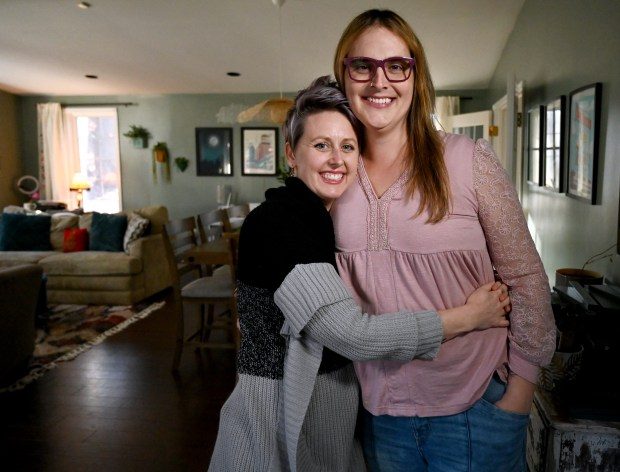One LGBTQ+ couple’s move from the Midwest to Maryland: ‘Less people need to hide here’
- January 3, 2024

In the entryway of Nia and Katie Chiaramonte’s Baltimore County home, there’s a framed print that reads “Protect Iowa’s trans youth,” the letters adorned with vines sprouting pastel pink and blue flowers.
Not quite two years ago, the couple was living in Indianola, Iowa, and Nia had conceived a plan to stick it out for five more years in the state where they were both born, went to school together and started their family, but where they no longer felt at home.
“I was like, ‘OK, you want to move? Here’s the PowerPoint,’” Nia, who came out as a transgender woman in 2018, recalled telling her wife. “I was trying to help her understand a path out of Iowa. … If we don’t move tomorrow, it feels like there’s not a path.”
“I broke down completely,” Katie said. “I was like, ‘Five years?’ I think that was really when it hit me — I don’t feel like I can do this five more days, let alone five more years.”
In search of a place where being transgender and queer didn’t feel like a battle, the Chiaramontes moved to Maryland in the fall of 2022.
More LGBTQ+ people have since flocked to the Baltimore area after Gov. Wes Moore signed an executive order last summer protecting gender-affirming health care in the state. The Chiaramontes did so after filming “We Live Here: The Midwest,” a Hulu documentary about the perseverance of LGBTQ+ families that aired Dec. 6.
“This is not giving up,” Katie said.
‘Your community ends’
Katie and Nia met in second grade, became best friends in eighth grade and were dating by the time they were juniors in high school. After their third year at the University of Northern Iowa, they tied the knot. The couple began raising five children, one adopted — all before Nia came out publicly as trans.
“Someone asked me if they were going to stay together, when Nia came out,” said Katie’s younger sister, Samantha Jones-Tweedy. “That didn’t even cross my mind.”
She recalled Nia telling her that she liked to dress up, after they’d been talking about the TV series “RuPaul’s Drag Race.” A few days later, Nia came out as trans, Jones-Tweedy said.
“We became very conspicuous,” Nia, 41, said. “There’s not super explicit hate. There’s not even typically people being mean to you. But it’s this hum of stress all the time.”
Still, Nia said she received messages on social media telling her she was “going to hell.” In public, the couple feared Nia getting “clocked” — perceived as transgender — when using the restroom, or someone calling Child Protective Services.
There were “people coming to talk to me with these weird tones of like, ‘Hey, I heard what happened with your brother,’” said Nia’s younger brother, Chris Chiaramonte. “It’s hard to just launch into a full-blown conversation about why, potentially, their worldview is wrong.”
The siblings share similar liberal-leaning social beliefs, despite their conservative Christian upbringing, he said.
Religion remained an important part of Katie’s and Nia’s lives in adulthood; Katie had been preaching and serving as a lay pastor in a nondenominational evangelical church when Nia came out, but people began attacking her expanding theology, she said, and the couple eventually left.
“Homosexuality was [a] no-go in our tradition,” Katie, 40, said. “When your church community ends, your community ends.”
The Chiaramontes said they also felt targeted by their state’s legislature. In January 2020, Republican lawmakers introduced a bill to remove gender identity as a protected class under the Iowa Civil Rights Act.
“Maybe people will understand our family if they see us and our kids,” Nia recalled thinking.
But conversations with Republican legislators revealed that “the people making decisions for us, as a community, do not fully understand the community,” Katie said. “Things are so muddled and the rhetoric is so high.”
While Nia found a strong LGBTQ+ community in Des Moines, Katie’s struggle became apparent even in the way she presented herself.
“Katie has this major tell when she is not in the right headspace. … She doesn’t dye her hair purple anymore,” her sister said. “And she hadn’t had her hair purple for a very long time.”
Filming a documentary
In March 2022, the Chiaramontes spent two days on camera for the documentary that would become Hulu’s “We Live Here: The Midwest.”
“We have always been open with our lives, because no matter what stage we’re in, we understand we don’t have to be perfect,” Katie said. “We’re people in process, and people need to see that process.”

Filmmakers David Miller and Melinda Maerker set their focus on challenges faced by LGBTQ+ families in the Midwest, “the heartland of family values where, ironically, many families face discrimination,” Maerker told The Baltimore Sun in a written statement.
Since the film’s release, Katie said she’s received invitations from viewers to join their churches in the Midwest. But even during filming, the Chiaramontes foreshadowed their eventual move out of the state.
“Do we stay and fight, or do we go somewhere?” Katie says in the documentary. “But where do you go where putting down roots is acceptable, where there’s stability and safety?”
‘No one is left behind’
The couple opened their search for a new home to the DMV area because they have a few friends in Virginia, and settled on Maryland when Nia received a job offer to work in human resources.
Maryland’s political climate felt like it would be more stable than in some other states. “I appreciated the fact that there was this Republican governor, blue legislature, and they were still working and getting things done,” Nia said.
Since taking office in 2023, Moore, a Democrat, has championed transgender rights, signing the Trans Health Equity Act in May to require that Medicaid cover gender-affirming care in 2024 and a June executive order to “protect those seeking, receiving, or providing gender affirming care in Maryland from attempts at legal punishment by other states.”
After Moore signed the executive order, calls to Baltimore Safe Haven, a nonprofit that provides transitional housing and other services for LGBTQ+ people, spiked to around 7,000 in the first month, founder and executive director Iya Dammons said.
“It felt like the people were coming here by the boatload,” she said. “We were calling them refugees.”
In July the organization received a $2 million grant from United Way, through March 2025, to fund expenses, including rent and utility bills, for Baltimore Safe Haven clients, said Akin Abioye, Baltimore Safe Haven’s operations director. The need is still great and Dammons continues to call on the city and state for help managing what she called a “dire situation.”
People from across the country have been traveling to Maryland for gender-affirming surgeries and in search of a new place to live, Dammons said. “We have great leadership here in Maryland,” she said. “No one is left behind.”
Settling in
Soon after the Chiaramontes moved to Maryland, Katie’s sister came to visit. In Baltimore County, she said her sibling has been keeping her hair “light and bright” — and purple.
“It was a relief,” Tweedy-Jones said. “I could see them, when I went to go visit them for the first time, just be very relaxed in their bodies, especially when we were out in public.”
More than a year into their new life in Maryland, Nia and Katie said they feel more understood — and they’ve encountered more people like themselves in everyday spaces.
In Maryland, the couple also found the peace needed to complete a book project they’ve been working on since 2022. They wanted to live in a place where “you don’t have to think about the fact that your identity exists, every single minute of every single day,” Katie said. Their book, “Embracing Queer Family,” is due out in May.
“Less people need to hide here, so being queer is more visible. So you just feel like a regular part of the fabric of your community,” said Katie, who works as a substitute teacher, writer and spiritual guide.
Their children spend time with others in their new neighborhood, and Katie has meditated with one of their neighbors.
“They had nothing to fear in our household,” said Sarah Treuhaft, who lives next door to the Chiaramontes.
They haven’t joined a new church in Maryland, but in mid-December attended a queer Christmas cabaret at the Baltimore City church Dreams and Visions.
They’ve visited beaches in Delaware, gone into D.C. a handful of times, and got museum and zoo passes.
In Iowa, Nia’s brother, Chris, now has a go-to response when he’s questioned about all of the changes in Nia’s and Katie’s lives: “They’ve moved out to Maryland, and everything seems to be going pretty well.”
Sign Up For Our
Newsletter
Each day, we honor and remember those who have recently passed away.
Most Viewed
More
- Article Obituaries
- Celebrities
- Celebrity News
- Local
- News
- News & Advice
- NFL
- NHL
- Northside
- Norwin
- Obituaries
- Obituary
- Penn Hills
- Pirates
- Pitt
- Pittsburgh
- Plum
- Politics Election
- Sports
- Steelers
- Theater Arts
- Top Stories
- Travel
- Tribune Review Obituaries
- US-World
- Valley News Dispatch
- West End
- Westmoreland
- World